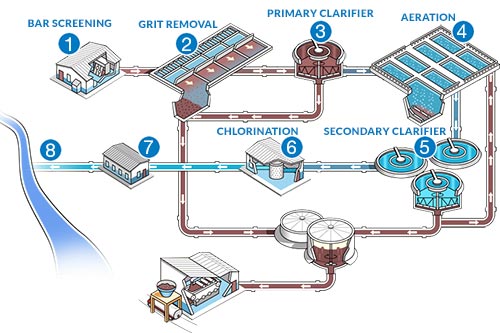The Connection Between Wastewater Management and Public Well-being
The Connection Between Wastewater Management and Public Well-being
Blog Article
Recognizing Wastewater Treatment Processes and Their Ecological Impact
The details of wastewater treatment procedures play a critical role in mitigating ecological difficulties related to water air pollution. Each phase, from initial to advanced treatments, is designed to address particular pollutants, eventually safeguarding both public health and wellness and marine ecological communities. Despite technical developments in treatment performance, considerable obstacles persist, consisting of the administration of recurring pollutants and the effects of nutrient drainage. As we check out the intricacies of these procedures, it comes to be necessary to doubt how much present techniques can advance to fulfill the growing needs of sustainability and ecological preservation.
Introduction of Wastewater Therapy
How is wastewater transformed right into a safe resource for the atmosphere? Wastewater therapy is an essential procedure designed to eliminate impurities from made use of water, thus securing public wellness and securing communities. This procedure starts with the collection of wastewater from residential, commercial, and industrial resources, which is then guided to treatment centers.
At these facilities, various physical, chemical, and organic techniques are employed to treat the wastewater. Initial screening removes huge particles, followed by sedimentation to different heavier solids. Ultimately, biological treatments, such as activated sludge processes, utilize microbes to damage down raw material. These techniques not just lower toxin levels however likewise promote the recuperation of valuable nutrients.
The dealt with effluent can be safely released into all-natural water bodies or recycled for irrigation and commercial functions, promoting resource preservation. In addition, the treatment procedure creates biosolids, which can be repurposed as fertilizers or dirt modifications, further boosting sustainability.
Stages of Treatment Procedures
The wastewater therapy procedure commonly is composed of three key phases: initial, main, and second therapy. Each stage offers a distinctive duty in minimizing the pollutant tons and guaranteeing the effluent fulfills environmental standards prior to discharge.

The key therapy stage concentrates on the physical splitting up of suspended solids from the wastewater. Through sedimentation, larger particles resolve at the bottom of sedimentation storage tanks, developing sludge, while lighter products, such as oils and oils, float to the surface area and are skimmed off. This procedure substantially lowers the organic and inorganic load in the wastewater.
Second treatment is an organic process aimed at additional decreasing the concentration of organic issue. This stage is necessary for achieving the essential biochemical oxygen need (BOD) reduction, eventually leading to cleaner effluent all set for discharge or further therapy.

Advanced Treatment Technologies
Complying with the second treatment procedures, advanced treatment modern technologies play an essential duty in more enhancing the quality of a fantastic read treated wastewater. These technologies are developed to remove residual contaminants that are not efficiently gotten rid of during key and second treatments, making certain the effluent meets stringent governing criteria.
Among the extensively used sophisticated therapy methods are membrane filtration, reverse osmosis, and advanced oxidation procedures. Membrane filtering, consisting of microfiltration and ultrafiltration, is effective in separating great bits, virus, and colloids from the water (Wastewater). Reverse osmosis makes use of he said semi-permeable membrane layers to remove liquified solids, leading to top quality water ideal for various applications
Advanced oxidation processes (AOPs) employ solid oxidants to deteriorate organic pollutants, consisting of drugs and individual care items that are resistant to standard treatment. These techniques boost the biodegradability of complex substances, promoting their removal.
Another significant innovation is using organic nutrient elimination procedures, which especially target nitrogen and phosphorus, stopping eutrophication in getting water bodies. On the whole, innovative therapy innovations are crucial for achieving greater degrees of filtration, promoting water reuse, and safeguarding public wellness while resolving the obstacles related to wastewater monitoring.
Environmental Advantages of Treatment
Countless ecological advantages arise from efficient wastewater treatment processes that add to ecosystem health and wellness and sustainability. Primarily, these procedures dramatically reduce the launch of damaging contaminants right into natural water bodies, which aids preserve water environments. By getting rid of impurities such as hefty steels, nutrients, and virus, dealt with wastewater reduces the risk of waterborne illness and advertises biodiversity in marine atmospheres.
Moreover, wastewater therapy centers often use advanced modern technologies that enable water recycling and reuse. This practice not only preserves freshwater resources however likewise lowers the need on all-natural water materials. Enhanced nutrient removal from wastewater can additionally protect against eutrophication, a procedure that results in algal flowers and succeeding oxygen deficiency in marine systems.
Additionally, efficient therapy procedures can minimize greenhouse gas exhausts, especially methane and laughing gas, which are often launched throughout untreated wastewater disintegration. By capturing and making use of biogas from anaerobic digesters, centers why not check here can transform waste right into renewable resource, thereby contributing to a reduction in fossil gas reliance.
Challenges and Future Patterns
While the ecological advantages of wastewater treatment are clear, several challenges linger that hinder optimum outcomes in this area. One major issue is maturing facilities, which frequently leads to ineffectiveness and boosted functional expenses - Wastewater. Several therapy plants were designed decades ago, and their capabilities do not line up with modern-day demands, which consist of more stringent regulatory requirements and higher volumes of wastewater as a result of urbanization

Looking ahead, there is a growing focus on resource recovery and circular economic situation concepts within wastewater therapy. Technologies such as anaerobic food digestion, which can produce biogas, and progressed filtering technologies are gaining grip. These approaches not only improve therapy effectiveness yet also advertise sustainability.
Ultimately, addressing these challenges calls for partnership among stakeholders, financial investment in technology, and a dedication to ongoing study. By embracing these fads, the wastewater treatment industry can evolve to meet the needs of a changing setting and culture.
Verdict
In verdict, wastewater therapy procedures play an important function in boosting environmental high quality and public wellness. The multi-stage therapy structure, coupled with innovative modern technologies, successfully mitigates contamination and advertises lasting water administration.
Report this page